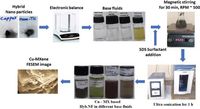In a significant advancement in thermal management technology, researchers have explored the effectiveness of Cu-MXene hybrid nanofluids within a double-pipe heat exchanger (DPHE), revealing profound improvements in heat transfer efficiency. This investigation, undertaken by a team at the Vellore Institute of Technology, attempts to revolutionize applications ranging from automotive cooling systems to industrial heat exchangers.
The study centers around the performance analysis of double-pipe heat exchangers utilizing innovative hybrid nanofluids composed of low concentrations (0.02–0.06 vol%) of water, methanol, castor oil, and silicon oil infused with Cu-MXene mixtures. By employing convective heat transfer experiments, the researchers meticulously measured crucial thermal parameters such as Nusselt number (Nu), heat transfer coefficient (h), and thermal performance factors (TPF), establishing a benchmark for future research in nanofluids.
The experimental setup involved a modular double pipe heat exchanger designed for efficient thermal exchange without traditional enhancements like twisted tapes, allowing for a more straightforward yet effective performance evaluation. Results indicated that the Cu-MXene hybrid nanofluids significantly enhanced the Nusselt number, heat transfer coefficient, and overall heat transfer coefficient while maintaining an acceptable pressure drop. These indicators point toward an expanded application of hybrid nano-coolants capable of optimizing heat transfer in complex systems.
As detailed in the study, "the TPF value of methanol and water-based hybrid nanofluids exceeded unity and showed superior heat transfer characteristics, confirming the viability of improving thermal performance in DPHE." The research demonstrated that the modified nanofluids achieved notable heat transfer rate enhancements, yielding improvements of 216%, 146%, 60%, and 82% for methanol, water, silicon oil, and castor oil, respectively, under similar conditions.
Additionally, the research highlighted the substantial pressure drop enhancements of the Cu-MXene nanofluids, with increases noted at 113% for methanol-based solutions and 65% for water-based variants. These findings suggest that while hybrid nanofluids can substantially enhance thermal transfer capabilities, careful consideration of fluid dynamics in practical applications will be essential to optimize performance.
Past studies emphasized that traditional fluid systems often fall short in high-performance requirements, where the specific characteristics of hybrid nanofluids provide solutions aligned with modern thermal management needs. The synthesized Cu-MXene variant not only improves thermal conductivity but also stands as a cost-effective alternative to conventional cooler fluids historically used in cooling applications.
Validation efforts using the Aspen HYSYS simulation software displayed promising correlations with experimental results, affirming that variations of less than ±5.35% for heat transfer coefficients were achievable, thereby underlining the reliability of the research methods employed.
The implications of this research span beyond mere enhancements in thermal fluid technology. The successful deployment of low-volume hybrid nanofluids like those investigated can significantly impact sectors that require reliable and efficient thermal management systems, such as electronics cooling, automotive applications, and industrial manufacturing processes. The enhancement of heat exchanger efficiency contributes to energy savings and potentially reduces operational costs across various industries.
Moreover, addressing concerns regarding temperature stability and maintaining hydrodynamic behavior at low nanoparticle concentrations presents opportunities to explore additional applications in emerging fields such as aerospace, biomedical technologies, and renewable energy systems.
In conclusion, the ongoing exploration of Cu-MXene hybrid nanofluids for thermal exchange applications holds promise for the future of heat transfer technologies. With enhanced efficiency and effectiveness, these innovations could spearhead the transition towards more sustainable and advanced cooling solutions in diverse industrial contexts. Further research is encouraged to explore the long-term viability and operational capabilities of these innovative nanofluids in real-world environments.

